In the race against climate change, green technologies of the future are rapidly emerging as powerful solutions to build a more sustainable world. From renewable energy breakthroughs and smart grids to carbon capture and eco-friendly transportation, these innovations are no longer distant concepts—they’re shaping today's global environmental agenda. This article integrates insights from reputable sources like IBM, SG Analytics, and Greenly to provide an in-depth look at cutting-edge developments poised to redefine how we power our lives, feed our populations, and protect the planet.
Green Technologies of the Future: Which Developments Will Save the World?
As the world grapples with the escalating challenges of climate change, green technology emerges as a beacon of hope, offering innovative solutions to reduce environmental impact and promote sustainability. From renewable energy advancements to sustainable agriculture practices, these technologies mitigate ecological damage and pave the way for a greener, more resilient future.

🔋 Renewable Energy Sources: Harnessing Nature's Power
Renewable energy stands at the forefront of green technology. Solar and wind power, in particular, have seen significant advancements, making them more cost-competitive and accessible. According to SG Analytics, by 2025, solar and wind energy are expected to be central to the global energy mix, driven by technological progress and policy support. (SG Analytics)
Institutions like IIT Delhi are contributing to this progress by developing low-cost electric vehicle (EV) motors that use fewer rare-earth materials, making EVs more affordable and environmentally sustainable.
⚡ Energy Storage: Ensuring Reliability
One of the challenges with renewable energy is its intermittency. Advancements in energy storage solutions, such as high-capacity batteries, are crucial for integrating renewable sources into the grid. These technologies ensure a stable and reliable energy supply, even when the sun isn't shining or the wind isn't blowing.
Countries like Germany, South Korea, and Australia are leading the way in deploying large-scale battery storage systems. Germany’s Energiewende (energy transition) policy has driven massive investments in lithium-ion batteries and grid-scale storage solutions. South Korea, meanwhile, has implemented aggressive government incentives to boost its domestic energy storage market. In Australia, the Hornsdale Power Reserve (backed by Tesla) has demonstrated the potential of battery storage to stabilize entire grid systems during peak demand or outages.

Carbon Capture and Storage (CCS): Reducing Emissions
Carbon capture and storage technologies aim to capture carbon dioxide emissions from industrial processes and power plants, preventing them from entering the atmosphere. The CSIR-National Environmental Engineering Research Institute (NEERI) in India is actively working on scalable carbon capture technologies aimed at reducing industrial emissions. The Times of India
Globally, countries like Norway, Canada, and the United States are pioneering CCS projects. Norway’s Northern Lights project is one of the first large-scale CCS projects to transport and store CO2 under the seabed. Canada’s Boundary Dam and the U.S.’s Petra Nova project showcase how CCS can be integrated with coal-fired plants to dramatically reduce emissions.
For developing economies, CCS deployment depends on financial and technological support from international partners. Establishing regulatory frameworks and carbon pricing mechanisms can make these technologies more viable. Collaboration with universities and innovation hubs can accelerate the development of localized CCS technologies tailored to specific industrial needs.
🌾 Sustainable Agriculture: Feeding the Future
Sustainable agriculture practices, such as agroforestry, crop rotation, and no-till farming, play a vital role in reducing carbon emissions, improving soil health, and enhancing water conservation. These methods not only ensure food security but also contribute to environmental preservation.
Countries like Brazil, India, and Kenya are embracing sustainable agricultural practices to combat land degradation and food insecurity. Brazil’s adoption of integrated crop-livestock-forestry systems has increased productivity while preserving biodiversity. India’s National Mission on Sustainable Agriculture promotes water-efficient practices and organic farming. In Kenya, agroforestry and permaculture techniques are helping smallholder farmers adapt to climate change.
🚗 Electric Vehicles (EVs): Driving Towards Sustainability
The transition to electric vehicles is crucial for reducing emissions from the transportation sector. Innovations in EV technology, including the development of affordable and efficient motors, are making electric transportation more accessible to the masses. IIT Delhi's initiative to design low-cost EV motors exemplifies this progress. The Times of India
China, Norway, and the United States are setting benchmarks in EV adoption. China has the largest EV market, supported by government subsidies and infrastructure development. Norway leads in per capita EV usage, with over 80% of new car sales being electric, thanks to tax exemptions and widespread charging infrastructure. The U.S. is ramping up efforts through federal incentives and manufacturing investments under the Inflation Reduction Act.

♻️ Circular Economy: Minimizing Waste
Embracing a circular economy involves focusing on resource efficiency, waste reduction, and recycling. This approach minimizes environmental impact by ensuring that products and materials are reused and recycled, reducing the need for new resources and decreasing pollution.
The European Union is at the forefront of circular economy initiatives, with its Circular Economy Action Plan aiming to make sustainable products the norm. Japan has implemented effective policies on waste sorting and electronic recycling, significantly reducing landfill usage. The Netherlands is working toward a fully circular economy by 2050.
🧠 Artificial Intelligence in Green Tech: Smart Solutions
Artificial intelligence (AI) is increasingly being used to optimize processes, monitor environmental conditions, and predict resource consumption. IBM, for instance, is leveraging AI to enhance energy efficiency and support environmental applications, such as reforestation programs. The Cool Down
Singapore, Canada, and the United Kingdom are using AI in environmental management. Singapore applies AI in smart city planning to reduce emissions, while Canada integrates AI in wildfire prediction and resource optimization. The UK uses AI-driven tools to monitor energy usage and develop predictive climate models. To implement AI in green tech, countries need robust digital infrastructure, skilled data scientists, and cross-sector collaboration. Investments in open data platforms and ethical AI frameworks can help scale sustainable applications.

Green Buildings: Sustainable Architecture
Incorporating energy-efficient technologies, sustainable materials, and green roofs in building design can significantly reduce energy consumption and environmental impact. Green buildings not only lower operational costs but also provide healthier living and working environments.
Sweden, Singapore, and the United Arab Emirates have made major strides in green architecture. Sweden leads with its near-zero energy homes. Singapore's Green Mark certification incentivizes sustainable building practices, while the UAE’s Masdar City exemplifies eco-city design with solar power and energy-efficient architecture.
🔌 Smart Grids: Optimizing Energy Distribution
Smart grids utilize digital technology to monitor and manage the transmission of electricity from all generation sources to meet the varying electricity demands of end-users. These intelligent systems enhance the efficiency, reliability, and sustainability of electricity services.
South Korea, Germany, and the United States have implemented smart grid systems to modernize their energy infrastructure. South Korea’s Smart Grid Initiative integrates renewables and promotes demand response programs. Germany’s smart meters allow real-time monitoring and efficient load balancing. In the U.S., utilities are deploying AI-enhanced grids to reduce blackouts and optimize peak load usage.
🌍 Global Collaborations: A Unified Effort
International collaborations are essential for advancing green technologies. NEERI's partnership with the IVL Swedish Environmental Research Institute to establish a Centre of Excellence focused on water and wastewater treatment exemplifies the global effort to promote environmental sustainability.
Collaborations through platforms like the United Nations Framework Convention on Climate Change (UNFCCC), Mission Innovation, and the International Renewable Energy Agency (IRENA) enable countries to share best practices and fund research in clean technologies. For instance, India’s cooperation with Sweden and France has yielded significant advancements in clean water and solar energy systems. To strengthen global collaboration, countries should join climate-focused alliances, commit to transparent data sharing, and invest in cross-border pilot programs. Engaging academia, private companies, and local communities in these efforts ensures scalable and inclusive green solutions.








